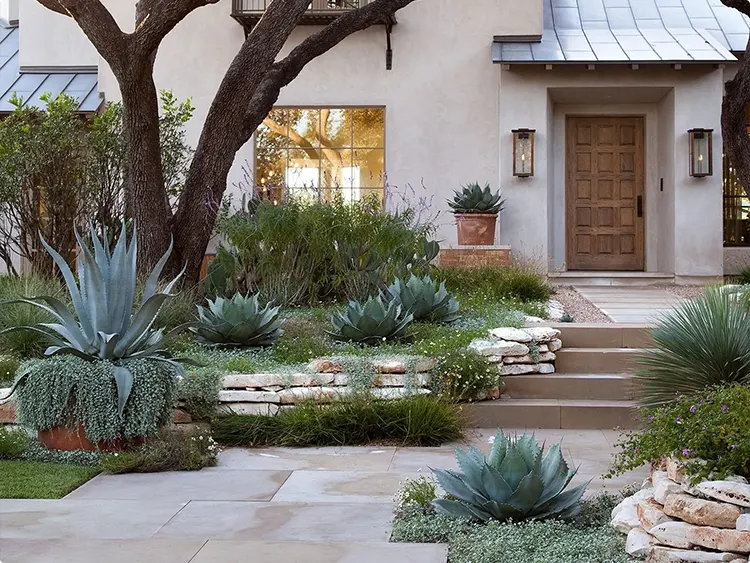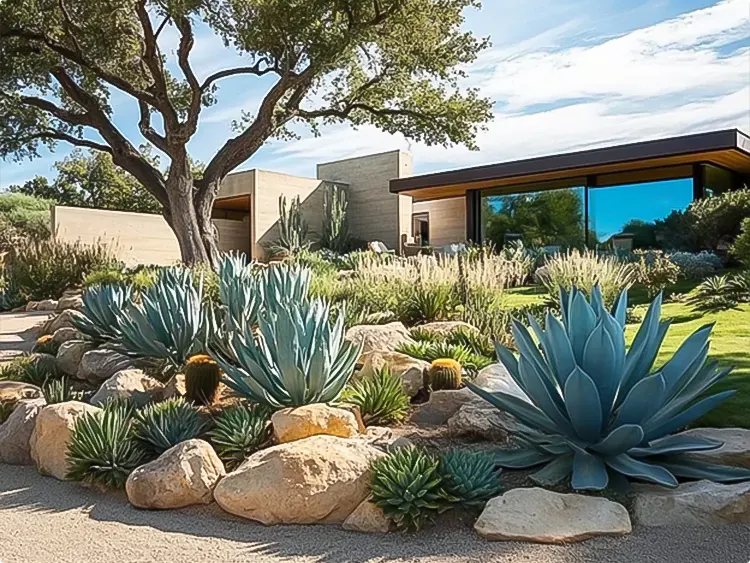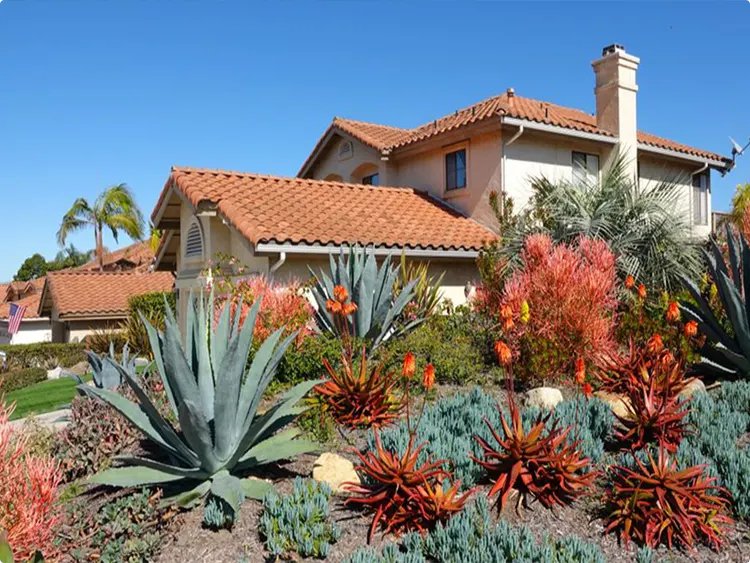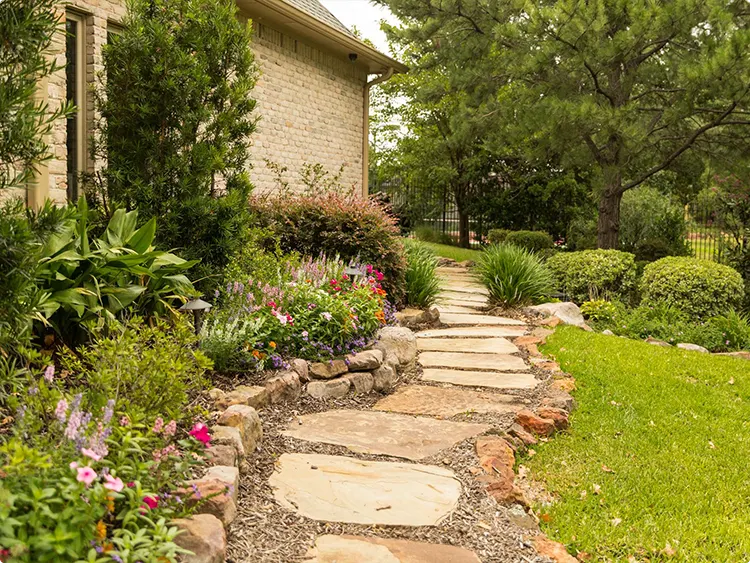
Dealing with the Texas heat is no joke, and trying to keep a traditional lawn alive during a drought can feel like a losing battle.
That is why so many homeowners are switching to native plants. They are built for the climate, save you a ton on water bills, and look incredible year-round.
You don’t have to sacrifice curb appeal to go water-wise. In fact, using local plants often gives your home a unique, high-end look that stands out in the neighborhood.

From modern rock gardens to soft wildflower beds, the options are endless. Check out these Front Yard Texas Native Landscaping Ideas to help you design a space that loves the Texas weather as much as you do.
Also Read: 19 Brilliant Front of House Landscaping Ideas
White Gravel Circle With Desert Accents

White gravel creates this clean circle that makes everything pop. The prickly pear and yucca sit right in the center like little sculptures.
Behind them, there’s a mix of purple blooms and green ground cover that softens the whole thing. It’s low maintenance because those rocks don’t need water.
The contrast between the white stones and all that green is what makes this work.
Stone House With Quiet Native Beds

The front beds here are filled with native grasses and low shrubs that don’t scream for attention. They just sit there looking nice.
There’s a big agave off to the side that anchors everything. The rest is subtle, letting the stone house be the main event.
I like how the plants are layered by height. It feels thought out but not fussy.
Colorful Slope Garden With Wildflowers

This hillside is bursting with yellows, pinks, and purples. It’s basically a wildflower party.
The mulch keeps weeds down while those blooms do their thing. A big chunk of natural rock sits right in the foreground like it’s always been there.
Slopes are tricky, but covering them in natives that don’t mind dry soil is smart. Plus it looks happy.
Also Read: 19 Creative Rock Front Yard Landscaping Ideas
Curved Bed With Ornamental Grasses

Those curved stone borders give the bed a nice flow. Inside, you’ve got clumps of ornamental grasses mixed with wildflowers.
The grasses sway when the wind picks up, which is kind of nice to watch. Everything here is pretty drought-tolerant once it settles in.
The black fence in the back makes all those greens and purples stand out even more.
Agave Pathway With Modern Vibe

Big blue agaves line the walkway like they’re guarding the front door. The stone steps and gravel keep things simple and modern.
There’s a mature tree providing shade, which is huge in Texas. The rest is just agaves, some ground cover, and a few accent rocks.
It’s clean, it’s low water, and it looks expensive without trying too hard.
Desert Modern With Bold Succulents

This yard went all in on the desert look. Massive blue agaves, barrel cactus, golden boulders everywhere.
The modern house makes sense with this style. Everything feels intentional, like someone planned each rock placement.
The driveway curves right through it all, so you’re basically driving through a curated desert. It’s bold but it works.
Succulents and Coral Pops

The mix of blue-green succulents with those orange and coral tones is really striking. It’s not your typical green yard.
Those spiky aloes add drama, and the color combo feels tropical even though these are tough desert plants. The lawn in the back keeps it from being too intense.
If you want color without annuals, this is how you do it.
Sloped Lawn With Native Border

The yard itself is mostly grass, but that curved border along the driveway is pure native magic. Big agave, low ground cover, natural stone edging.
It’s a nice compromise if you still want some lawn but also want to cut back on water. The trees provide shade, and everything feels balanced.
Simple but effective.
Prickly Pear and Boulder Drama

Prickly pear takes center stage here, surrounded by river rock and a massive natural boulder. There’s purple salvia blooming in the background.
The driveway curves past it all, so you see this setup every time you come home. It’s like the yard is saying “we live in Texas and we’re cool with it.”
Low effort, high impact.
Terraced Beds With Native Shrubs

The curved stone walls create these terraced levels filled with native shrubs and grasses. Everything is green and lush without being thirsty.
Those pavers give the yard definition, and the planting beds follow the natural slope. It’s structured but still feels organic.
I like how it all flows together.
Gravel Walkway Through Blooming Natives

That gravel path cuts right through beds packed with orange and red blooms. The silvery foliage adds contrast.
Walking to the door feels like you’re strolling through a little meadow. The plants spill over onto the path, which I think looks better than keeping everything tight and trimmed.
It’s casual in the best way.
Paver Fan With Layered Planting

The herringbone pavers fan out in this cool pattern. The beds around them are filled with layers of texture and color.
There’s purple blooms, chartreuse shrubs, silvery ground cover. It’s a lot happening, but it doesn’t feel chaotic.
The brick edging keeps everything contained. This is what happens when someone really plans their plant palette.
Sunlit Hillside With Bright Blooms

This slope is covered in yellows, silvers, and pinks, all soaking up the sun. The natural stone steps lead you up through it.
It’s almost like a cottage garden, but with Texas-tough plants. Everything here can handle heat and won’t pout if you forget to water.
The color blocking is what makes this pop.
Rustic Patina Walls With Modern Planting

Those rust-colored walls are such a cool backdrop. The agaves and grasses planted in front look super modern against them.
The flagstone patio ties it all together. There’s a circular planter with succulents that adds a fun focal point.
It’s proof that you can mix rustic and contemporary and have it make sense.
Terraced Hillside Bursting With Color

This hillside garden is basically a rainbow. Yellows, pinks, silvers, purples, all stacked up the slope.
The brick path curves through it, so you’re surrounded by blooms. It’s a lot of color, but it works because the planting feels natural, not forced.
If you’ve got a slope to fill, this is inspiration.
Patchwork Planting With Native Variety

This yard looks like a quilt made of plants. Each section has a different color and texture.
There’s orange blooms, pink clusters, silver foliage, dark purple accents. The stone edging separates each patch.
It’s playful and shows off just how many different natives you can use. I bet the bees and butterflies love this place.
Stacked Stone Bed With Fresh Starts

The stacked stone border creates a raised bed with dark mulch. A few small trees and plants are just getting established.
It’s simple and clean, perfect if you’re starting from scratch. The lawn around it keeps things traditional while the native bed adds interest.
Give it a year and this will fill in beautifully.
Palm and Flower Explosion

The ponytail palm is the star, but those flower beds are stealing the show. Reds, pinks, yellows, whites, all packed together.
It’s colorful without being tacky. The green lawn sets it off, and the whole thing feels tropical even though these are tough Texas plants.
This is what happens when you’re not afraid of color.
Flagstone Path With Native Borders

The irregular flagstone path winds through beds of native grasses and blooming plants. Pink flowers peek out along the edges.
It’s charming and feels handmade in a good way. The path invites you to take your time getting to the door.
I like how the plants soften the stone without covering it up.
Formal Garden With Playful Touches

This yard has structure with those trimmed hedges and gravel paths, but there’s whimsy too. Garden art, colorful blooms, that fun red sculpture.
The ponytail palm adds height, and the flower beds are packed with color. It’s formal but not stuffy.
You can have structure and still have fun with it.
FAQs About Texas Native Landscaping
What are the best native Texas plants for front yards?
Bluebonnets, black-eyed Susans, and Texas sage are solid picks. Agave, yucca, and prickly pear work great if you want something sculptural.
For grasses, try muhly grass or inland sea oats. They move nicely in the breeze and don’t need much water once they’re settled.
How much does native landscaping cost in Texas?
It depends on what you’re doing. If you’re starting from scratch, expect to spend anywhere from a few hundred to several thousand dollars.
Native plants are usually cheaper than fancy imports. The real savings come later when your water bill drops.
Rock and gravel are affordable ground covers. Labor is usually the biggest expense if you’re hiring someone.
Do native Texas plants need a lot of maintenance?
Not really, that’s the whole point. Once they’re established, they mostly take care of themselves.
You might need to trim things back once or twice a year. Maybe pull a few weeds in the beginning.
Watering is minimal after the first season. These plants are built for Texas, so they don’t need you hovering.
Will native landscaping attract snakes?
Any landscaping can attract snakes if it provides food and shelter. Rock piles and dense ground cover are favorites.
Keep your beds tidy and don’t create perfect hiding spots. Most Texas snakes aren’t dangerous anyway, but I get why people worry.
If it’s a real concern, stick with more open plantings and less rock coverage.
Can I mix native plants with non-natives?
Sure, people do it all the time. Just make sure the non-natives have similar water needs.
You don’t want to plant something thirsty next to drought-tolerant natives. That defeats the purpose.
The key is grouping plants by how much water they need. That way you’re not overwatering some and underwatering others.
